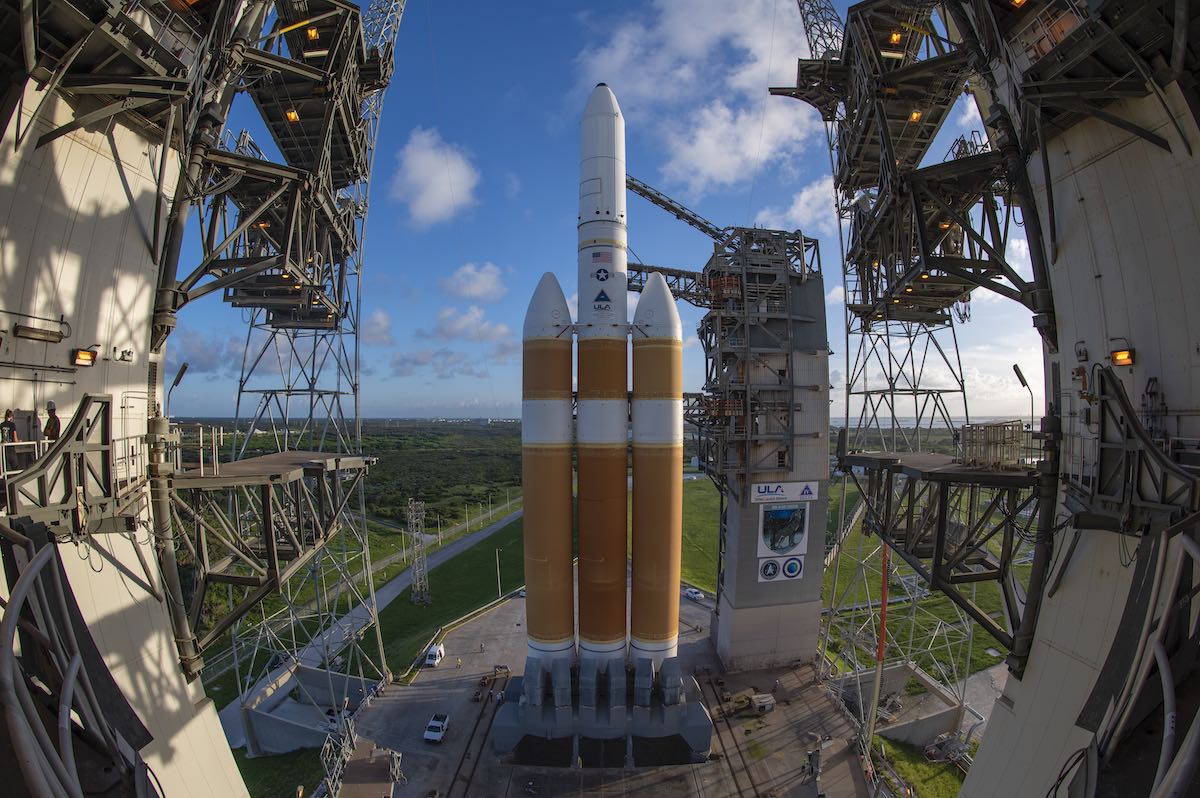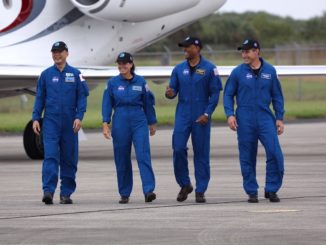EDITOR’S NOTE: Updated Sept. 25, 26 and 27 with launch delays.

United Launch Alliance’s next launch attempt for its Delta 4-Heavy rocket from Cape Canaveral with a top secret U.S. government spy satellite will be delayed to no earlier than early Tuesday.
ULA previously delayed the mission from early Saturday to early Sunday, then again to early Monday, to address a problem with the launch pad’s swing arm retraction system.
ULA said Sunday the company is “taking extra precautions to ensure all issues are resolved with the swing arm retraction system.“
The launch time Tuesday is set for just after midnight (0400 GMT).
ULA convened a Launch Readiness Review on Thursday morning to assess the status of launch preparations, the Delta 4-Heavy rocket, the rocket’s clandestine payload, and ground systems. Officials gave a unanimous “go” to continue preps to launch the heavy-lift rocket from pad 37B at Cape Canaveral early Saturday.
But officials announced Friday that the mission would be postponed to address a problem with the launch pad’s swing arm retraction system.
It will be the 41st flight of a Delta 4 rocket since 2002, and the 12th to use the rocket’s heavy-lift configuration.
The launch was previously delayed from late August, when ULA tried twice to send the Delta 4-Heavy into orbit. The last launch attempt Aug. 29 was automatically aborted just three seconds before liftoff.
ULA said engineers determined “a ground system regulator internal component failure was the cause of the on-pad abort.”
Three flow rate regulators on the launch pad are used in the high-pressure helium gas system that spins up the turbines on the Delta 4-Heavy’s three RS-68A main engines. The rocket’s starboard engine fired up normally, but a regulator for the center engine’s regulator did not open.
The Delta 4-Heavy is made of three common booster cores, each powered by a single Aerojet Rocketdyne RS-68A engine. The engines are timed to ignite in a staggered sequence in the last few seconds before launch, beginning with the starboard engine and followed by the center and port engines.
Tory Bruno, ULA’s president and CEO, said the root cause of the regulator problem was a torn diaphragm. Bruno tweeted that the diaphragm tear appeared to be caused by wear and fatigue, and engineers checked the health of all three regulators at pad 37B.
In an update earlier this week, Bruno said engineers removed the three regulators, refurbished the units, then tested them at NASA’s Stennis Space Center in Mississippi. The regulators were then reinstalled at the Delta 4 launch pad.
There is an 80 percent chance of acceptable weather during Sunday’s early morning launch window, according to the U.S. Space Force’s 45th Weather Squadron.
ULA’s launch team will commence the countdown and retract a mobile gantry away from the 235-foot-tall (71.6-meter) Delta 4-Heavy rocket on Friday afternoon, setting the stage for loading of super-cold liquid hydrogen and liquid oxygen into the launcher’s three first stage cores and upper stage.
The Delta 4 team will voice their approval to proceed with the launch during a pre-planned hold in the countdown at T-minus 4 minutes. Once the countdown resumes, the Delta 4-Heavy’s propellant tanks will be pressurized and the rocket switched to internal power before the ignition sequence begins at T-minus 7 seconds for the launcher’s three RS-68A main engines.
The three hydrogen-fueled engines will power the Delta 4-Heavy — the most powerful vehicle in ULA’s fleet — on a trajectory east from Cape Canaveral.
The Delta 4-Heavy is launching a payload for the National Reconnaissance Office, which owns the U.S. government’s fleet of intelligence-gathering satellites. The mission is designated NROL-44, and the NRO has not disclosed details about the payload’s purpose or design.
But public information about the rocket’s trajectory suggests the Delta 4-Heavy will deploy its payload near geosynchronous orbit more than 22,000 miles (nearly 36,000 kilometers). The NRO operates signals intelligence satellites in geosynchronous orbit to intercept data, voice and other communications from U.S. adversaries.
It will take roughly six hours for the Delta 4-Heavy to place the NROL-44 payload into its targeted geosynchronous orbit near the equator.
The rocket’s three RS-68A main engines engines will consume three tons of liquid hydrogen and liquid oxygen propellants per second to power the Delta 4-Heavy rocket off the pad with 2.1 million pounds of thrust, equivalent to 51 million horsepower.
The rocket’s two 15-story side boosters will shut down their engines and jettison from the core stage nearly four minutes into the mission, followed by cutoff of the core engine around five-and-a-half minutes after liftoff. The core stage will fall away seconds later, leaving the RL10 engine on the Delta 4’s upper stage to ignite for the first of three planned burns on Saturday’s mission.
But the most of the rest of the flight will occur under a government-ordered news blackout.
The Delta 4 will release its nose cone to shed weight and reveal the NROL-44 payload at T+plus 6 minutes, 37 seconds, once the rocket has climbed into space. The trisector fairing, designed especially to accommodate large NRO and military satellites, will jettison from the launcher in three pieces rather than in two halves like payload shrouds used on most other other rockets.
At that time, ULA will end its live coverage of the launch under orders from the NRO, and the rest of the launch sequence will occur without any real-time updates on the progress of the flight.
Read our earlier story previewing the Delta 4-Heavy’s launch sequence, with additional information on the NROL-44 payload.

The Delta 4 launch is the first of three missions planned to take off from the Space Coast in the coming days.
SpaceX’s next mission is scheduled for liftoff from pad 39A at NASA’s Kennedy Space Center at 10:22 a.m. EDT (1422 GMT) Monday.
The Falcon 9 rocket launching from pad 39A Monday will deploy 60 more spacecraft for SpaceX’s growing Starlink network of Internet-beaming satellites in orbit. It will be the 13th launch dedicated to delivering satellites for the Starlink fleet, extending a campaign that has allowed SpaceX to launch more than 700 Starlink craft to date.
The Falcon 9 rocket set for takeoff with the next Starlink satellites has also faced previous delays, but for a different reason.
SpaceX scrubbed a launch attempt Sept. 17 after ocean conditions in the Falcon 9 booster’s recovery zone proved unfavorable. SpaceX founder and CEO Elon Musk tweeted that the current in the Atlantic Ocean was too strong for the company’s football field-sized drone ship to hold position.
The drone ship returned to Port Canaveral earlier this week, and SpaceX deployed its other ocean-going rocket landing platform into the Atlantic Ocean on Wednesday, setting a course for the Falcon 9’s first stage landing zone roughly 400 miles (630 kilometers) northeast of Cape Canaveral.
SpaceX is the only company that recovers and reuses rocket boosters for orbital launches.
The busy launch schedule next week includes another Falcon 9 launch at 9:55 p.m. EDT Tuesday (0155 GMT Wednesday) from pad 40 at Cape Canaveral.
That mission will carry a U.S. military GPS navigation satellite into orbit, and is set to occur the same night as a Northrop Grumman Antares rocket is scheduled to blast off from Wallops Island, Virginia, on a commercial resupply flight to the International Space Station.
Email the author.
Follow Stephen Clark on Twitter: @StephenClark1.



